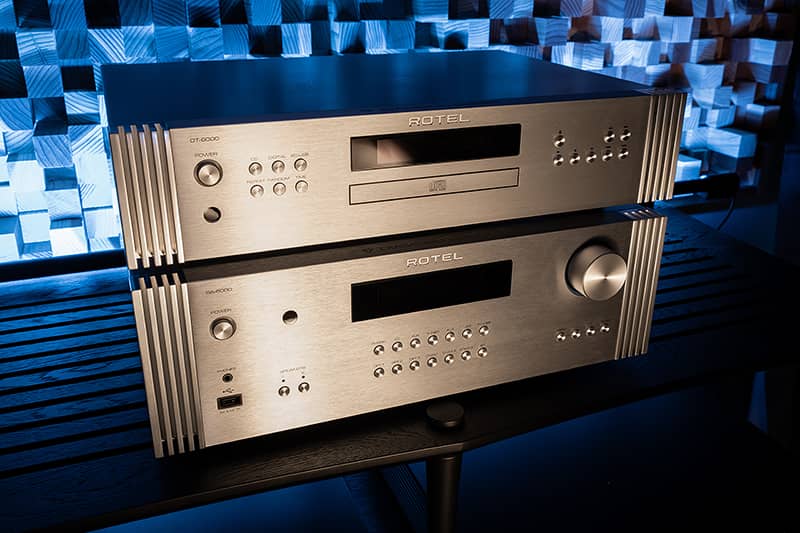TMR Exclusive Review: Rotel's 60th Anniversary Diamond Series, Part 3

As audiophiles, we all have our test tracks. Those pieces we know so intimately that we use them to suss out differences between equipment and cables. Sometimes, it’s useful to have music for testing which isn’t recorded or mastered well for one reason or another, to judge how some equipment handles it.
Toothpick test: Is it done?
 An example I often use is Larry Carlton and Lee Ritenour’s album Larry & Lee. I love this album, and while I do think it was recorded well, it really rides the line at the top frequencies, nudging right up to the border of being too hot & sizzly. The album will show me when a system or product is voiced a little too “HiFi” for my taste. If it sounds good and doesn’t make me wince a little or reach for earplugs, I know I’m getting somewhere.
An example I often use is Larry Carlton and Lee Ritenour’s album Larry & Lee. I love this album, and while I do think it was recorded well, it really rides the line at the top frequencies, nudging right up to the border of being too hot & sizzly. The album will show me when a system or product is voiced a little too “HiFi” for my taste. If it sounds good and doesn’t make me wince a little or reach for earplugs, I know I’m getting somewhere.
For the Diamond Series’ however, I needed something different, and I turned to a track that I knew contained slightly too much bass. I had no issues with the system’s top-end response, but the bottom frequencies were where I was hearing the biggest changes as time went on.
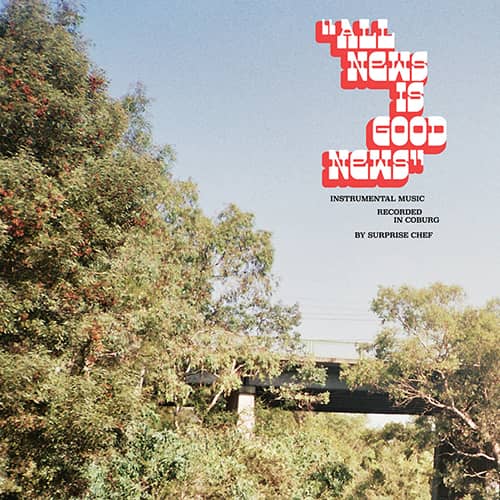 The kick drum in the track “Blythe Street Nocturne” by the band Surprise Chef on their album All News Is Good News is mixed just a little too high, and it took 150 hours of burn-in for me to finally hear this on the Diamond system. Where at first, the drum sounded like it was mixed a little low, after a week of constant burn-in work, it had bloomed up to be distracting in the mix, which is right where it should be.
The kick drum in the track “Blythe Street Nocturne” by the band Surprise Chef on their album All News Is Good News is mixed just a little too high, and it took 150 hours of burn-in for me to finally hear this on the Diamond system. Where at first, the drum sounded like it was mixed a little low, after a week of constant burn-in work, it had bloomed up to be distracting in the mix, which is right where it should be.
Why some tracks are mixed and mastered like that comes down to the difficulty of reproducing bass well enough to accurately monitor it. Plenty of folks, including professional studios, struggle with this. If you listen to a wide range of music like I do, including plenty of modern recordings with more fulsome spectral balance and sub bass information, you can eventually dial in the right subwoofer levels in your system to be able to come to the same conclusions about widespread mixing variability. A hallmark of a great system is its ability to easily show the differences between recordings, and the Diamond Series’ growth in resolution during the burn-in period was obvious.
Power cables
We’ve all been attracted to HiFi audio pieces based on reading about them. But some things that should be on a spec sheet are just impossible to convey if you don’t listen to the components. One of those I discovered was that the DT-6000 and RA-6000 system easily passes the “power cable test” which tells me a lot about the level of resolution in a system.
Thankfully, the well-designed RA-6000 doesn’t complain about being turned off and on repeatedly (with a little “discharge time” allowed, of course), so the test was fairly quick. When switching just the power cable of the DT-6000 between stock and a high-end cable, I could clearly hear the stock power cable collapse the images and soundstage toward the center, while adding a little bit of a glassiness on the high frequencies. The RA-6000 just sounded meeker and weaker when I switched back to a stock cable. Both products clearly show and respond well to power cable upgrades, so both to my ear exhibit a high level of resolution.
Bear in mind that both the RA-6000 and the DT-6000 are two-prong-power devices. They use double-insulated power supplies and have no earth ground connection, so intricately-grounded cables or passive grounding boxes will be left out of the fun. But clearly, as I found, upgraded cables at the power position make an impact. From this I would definitely recommend power cable upgrades to Diamond Series owners, to hear the full potential of these products.
Remote attack
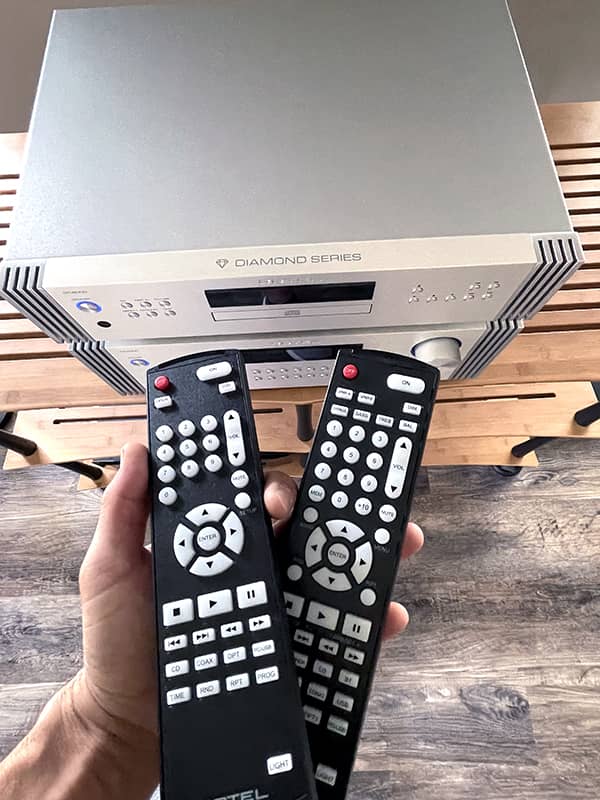 Let’s talk about the remotes. The only minor quibble I have about this impressive new system of gear from Rotel is that there’s two of them. I get it; the Diamond Series are individual components meant to stand alone or work together.
Let’s talk about the remotes. The only minor quibble I have about this impressive new system of gear from Rotel is that there’s two of them. I get it; the Diamond Series are individual components meant to stand alone or work together.
But in practice, having two almost identical remotes in place of the more straightforward (I would imagine) all-in-one is a little bit annoying. The integrated’s remote even features play/stop/forward/reverse buttons, tempting me to think I could control the CD player, but alas, I couldn't find a way to make it work. If I wanted to skip a track or pause the music, I’d first need to figure out which was the player remote, which could, in the absence of clear labeling or sufficient lighting, present a challenge.
I don’t consider this a big deal, but I thought it was worth mentioning as part of the experience of listening to these two pieces together. For anyone buying the RA-6000 or the DT-6000 individually, of course, this won’t come up.
The remotes feel solid for being housed in plastic, and the buttons light up quite brightly when pressed, to aid in use when the lighting is dimmed. The volume control ramp-up or down when holding the buttons is relatively slow, and it’s linear sounding in the sense that when the system is all dialed in and the volume goes up, the music feels like it gets bigger rather than particularly louder.
This slow volume rise is good for fine adjustments, and for the occasion when one accidentally sits on the remote. But of course, Rotel’s well-apportioned menu also allows for protective maximum volume limits to be quickly set, so system damage can be avoided altogether.
The amplifier remembers the last input and volume setting, not just when it’s taken out of standby, but when switched on from cold, too. I really appreciated this little feature as I was swapping out power cables and listening to the changes without having to switch inputs or wait for the volume to rise.
Listening impressions
After an adequate burn-in, my sonic impressions of the Diamond Series system together greatly exceeded expectations. Individually, I found them remarkable and neither lacking nor colored, but together they reminded me of audiophile systems involving much more extensive layout and outlay.
The amplifier particularly shone in its most basic role; amplifying analog signals. Its real muscle mated with nimble articulation, among other things, reminded me distinctly of my experiences with the Michi M8 monoblocks.
I bounced back and forth between CDs played from the DT-6000, the Raspberry Pi Roon source and another Roon endpoint, my PS Audio DirectStream Jr. DAC.
I didn’t have a turntable on hand and can’t comment about the moving magnet phono stage, but Rotel claims to be particularly proud of it. Given the design prowess exhibited elsewhere, I’m inclined to take their word that it’s an excellent, low-noise stage.
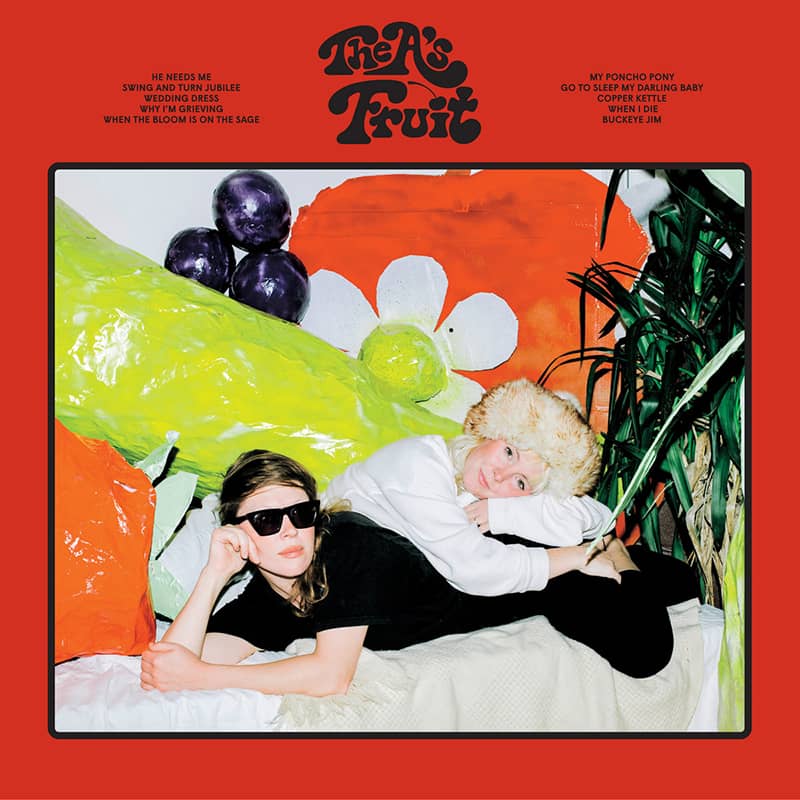 Fruit, a July debut release from the harmonious duo The A’s, has a track near the end that is wonderful for listening to the bass response of a system. “When I Die” buries a droning sub-synth line like a stomping boot heel throughout the melancholy prairie tune.
Fruit, a July debut release from the harmonious duo The A’s, has a track near the end that is wonderful for listening to the bass response of a system. “When I Die” buries a droning sub-synth line like a stomping boot heel throughout the melancholy prairie tune.
Finding the album on some streaming apps can be a challenge, where a search of “The A’s” leads the program to assume you meant all artists whose name begins with ‘A’, but the 10-track album is worth digging for. Both Qobuz and Tidal have it in 44.1KHz, with Qobuz’ version offering the full 24 bits.
The A’s, both also members of the all-female group Mountain Man, delight the ears and the Diamond Series system with this fantastic debut. It’s fun to hear the dominating drone of the bassline come out so taught and steady with the beefy RA-6000 pushing the load. It’s also a treat to hear every nuance of the room in which the vocals were recorded, with fleeting reverb tails fluttering on every syllable.
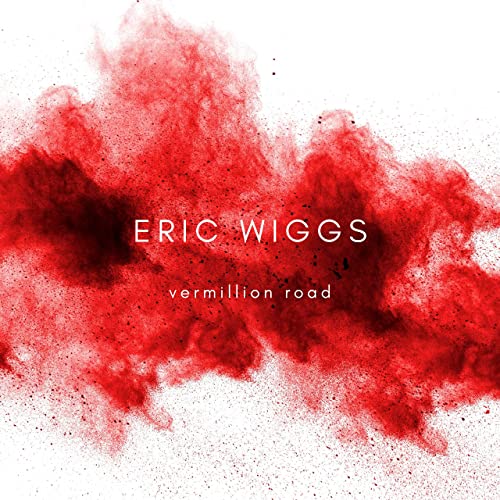 Switching to a CD, I pulled out my friend Eric Wiggs’ album Vermillion Road that he released last year in MQA on streaming platforms. The CD is also very good, and provides a test for the resolution of the player versus streamed high-resolution MQA.
Switching to a CD, I pulled out my friend Eric Wiggs’ album Vermillion Road that he released last year in MQA on streaming platforms. The CD is also very good, and provides a test for the resolution of the player versus streamed high-resolution MQA.
Curiously, the DT-6000’s CD drive played the music with more weight on every strum or pluck of Eric’s guitar, and offered a little more of the picking and harmonics of the strings in the high registers than the MQA. It separated the strings out just a little more in the second track, “Gimme A Holler.”
The cover of Pat Metheny’s “Question & Answer” for solo acoustic guitar intrigued me, and Eric did not disappoint. Track 7 via the CD player placed him in my room and his Martin guitar hanging in space between my speakers.
Once again, streaming via Roon through coaxial S/PDIF or via the MQA-capable and “Roon tested” USB input sounded fantastic, but somehow the analog outputs of the DT-6000 offered a more real, more dynamic and more vibrant image of Eric’s virtuosity, even though it was Redbook 44/16.
The more I listened to the combination of the DT-6000 and the RA-6000, properly broken in and extravagantly-cabled as befitting a Diamond Series moniker, the more I appreciated the CD as a source, and the more impressed I was at the quality level of this entire sub-$7K system.
 Julian Lage has a new album coming out mid-September, and the singles he’s been releasing are 11 out of 10 in both music and recording quality.
Julian Lage has a new album coming out mid-September, and the singles he’s been releasing are 11 out of 10 in both music and recording quality.
Set to hold the second track spot on the upcoming record View With A Room, the delightful “Word for Word” displays the system’s ability to show up as fleshy and harmonically rich when the recording calls for it. Lage’s hollowbody electric seems to resonate with your clothes and skin as the tones drop lower. The light snare work is pushed back in the soundstage and appropriately offers more room echo than does the sound of the close-miked guitar cab.
Via several pathways, streamed music sounds exceptional on the Diamond series system, and the remaining question of “why not include a streamer” in these devices, to me is swiftly and easily answered. At this level of fidelity, the owner of the Diamond Series system should invest in a standalone streamer unit with its own power supply and more physical space and circuit attention than could be given to another integrated feature in the well-designed duo from Rotel.
Conclusion
I was blown away by the excellence of this package from Rotel. Whatever I was expecting wasn’t close to this level of fidelity. At the price, and well above the price, this system together delivers so, so much.
Individually, the DT-6000 is a flexible and highly resolving digital do-it-all with remarkable CD playback; the RA-6000 is a ballet-dancing beast, breaking zero sweats while man-handling the speakers like the artist intended. It blooms, it bites, but most importantly it bows down before the recorded music.
This is one of the best integrated amps I’ve ever heard (and I’ve heard hundreds), and it’s for sure one of the best CD players (again– Rotel’s thirty-second design) I’ve ever used, and they both bestow honor on their high-tech makers with the gift for longevity.
Is it a gift, or is it a skill? Only Rotel would know the exact answer, but I would surmise that lasting 60 years in this challenging industry has something to do with how ridiculously good their products are.
At The Music Room, we’re proud to represent the 60-year-old HiFi legend, and wish Rotel success in the next 60 years. Maybe we’ll even be around to celebrate that anniversary. But in the meantime, we’ll be playing with our Diamonds.
Talk to one of our experts today about Rotel and Michi, and don’t forget to ask about trading in your old Rotel gear or other brands’ equipment to save on new models.
